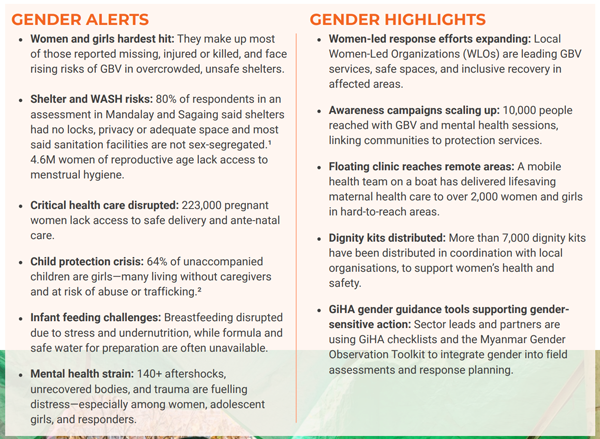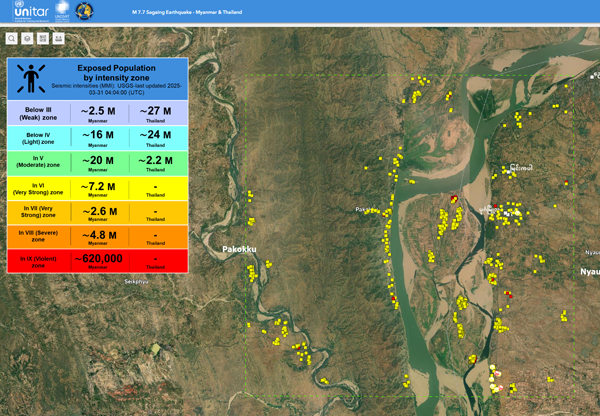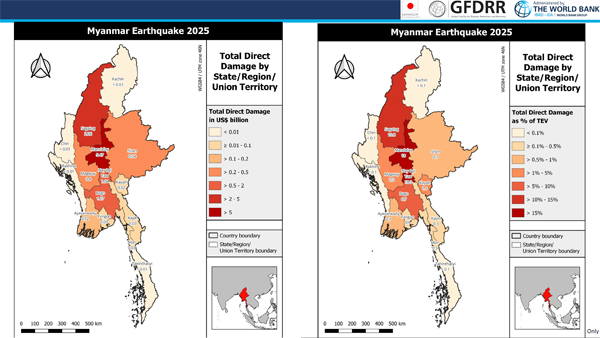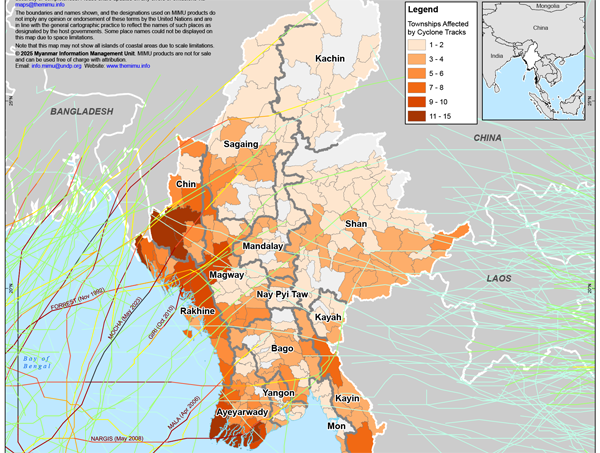Gender in Humanitarian Action Working Group (GiHA WG) recently published the Myanmar Earthquake Gender Situation Report No. 1, based on analysis and data voluntarily shared by GiHA members and their partners, highlighting emerging gendered risks, needs and gaps to inform humanitarian action.
📝 Read more in the report.
News
The Shelter/NFI & CCCM National Cluster has released its Myanmar Earthquake Response Strategy (May 2025). The plan sets out a two-phase approach to assist 753,000 people. Needs have surged from 1 million to 5.2 million people requiring shelter assistance after the 28 March earthquake, which damaged or destroyed more than 40,000 homes and left many families sleeping in the open.
Phase 1 (now under way) focuses on immediate life-saving relief such as the provision of non-food items (NFI) and emergency shelter over the first three months; Phase 2 starts immediately after Phase 1 and shifts to life-sustaining response such as shelter repairs and dignified transitional solutions before the monsoon. The strategy stresses DRR, gender and protection mainstreaming, and calls for urgent funding and enhanced coordination to scale up the response.
The monsoon has reached Myanmar this week, and a weather advisory warns of scattered to widespread rainfall, including isolated heavy downpours, across several regions and states between 14 – 20 May.
These rains can have adverse effects on earthquake recovery and response efforts, and they pose added challenges for affected communities still sleeping in the open, as noted above.
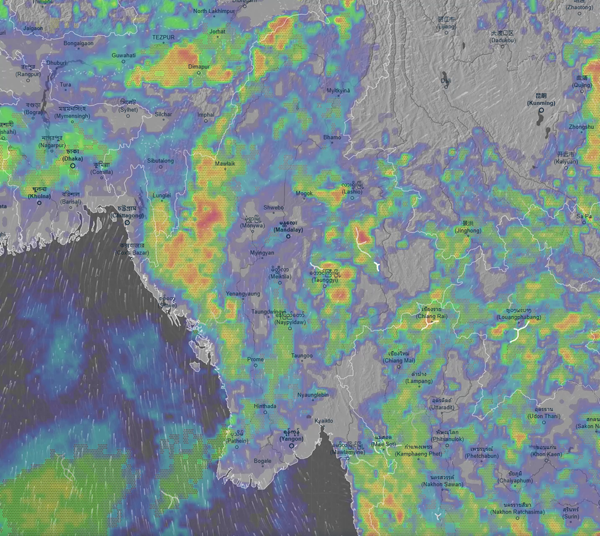
The Market Analysis Unit (MAU) previously released the report from the Rapid Market Assessment (RMA) conducted in 25 markets soon after the earthquake from April 1-10. This latest iteration is even more comprehensive and covers 59 earthquake/non-earthquake townships throughout 9 states/regions based on data collected from April 21-29.
The Market Analysis Unit is an independent project that provides donors, humanitarian responders, development practitioners and private sector actors in Myanmar with data and analysis to better understand the impacts of market developments, conflict and other crises on household purchasing power, supply chains, financial services, and labour markets.
The results of satellite-based remote sensing analyses from UNOSAT, including ground photos for validation, have been compiled into an interactive web map. Initially released last month, this map has recently been updated to include UNESCO-listed sites.
The World Bank has recently presented the results from Global RApid Post-Disaster Damage Estimation (GRADE) assessment.
- Total exposure of buildings (and contents) and infrastructure: USD 248 billion - Majority of assets in Yangon and Shan, Mandalay and Sagaing.
- US $10.97 billion in damages (≈ 14 % of 2024/25 GDP). Residential buildings and their contents account for 45 %, infrastructure 31 %, and non residential assets 24 %.
- GRADE results are similar to the Global Earthquake Model which estimates US$ 6.4 billion (unpublished & not detailed) in damage (for buildings only) vs. US$ 7.61 billion from GRADE (buildings and contents).
- There is significant uncertainty in the results. While GRADE ‘best estimate’ is US$10.97 billion there is an uncertainty range of US$ 6.2 billion to US$ 15.8 billion.
- State / Region level insights. The slides break down damage values and exposure for affected State / Regions including Yangon for economic impact.
- Modelling shows households lacking basic water, sanitation or education suffer up to 43 % higher per capita losses, underscoring the need for inclusive recovery measures.
The latest brief from the ILO highlights the negative impact of the earthquake on an already fragile labour and socioeconomic situation.
Upwards of 3.5 million workers were employed in the area directly impacted by the earthquake. This represents US$36.8 million in potential earnings lost per day (equivalent to US$9.6 billion in lost earnings per annum) if these workers are unable to work or find quality employment elsewhere.
In the short term, humanitarian emergency cash assistance is needed, ideally linked to decent employment promotion (for instance, in debris removal or infrastructure reconstruction) with fair wages that are based on the needs of workers and their families.
The ILO will continue to monitor the labour market and social consequences of the earthquake as more data become available. Future work will also provide greater insights on the medium term support measures that are needed to promote decent work and prevent abuses such as child labour or forced labour.
With the monsoon season coming soon along with the likelihood of tropical cyclones, earthquake recovery planning and management must be aware of potential impacts based on historical data, especially in areas already hit hardest by the earthquake.
MIMU has compiled storm track records for Myanmar dating back to 1960 and published a summary map. For those who wish to run their own analysis, create maps, or reference the data, the GIS layer that goes even further to 1842 is also available on the MIMU GeoNode platform.
Download the summary map.
Download the GIS layer for mapping.
Five weeks after the devastating earthquakes struck Myanmar on 28 March, many affected communities are still in urgent need of safe shelter, health care, clean water and sanitation, cash assistance and various forms of protection support.
An early monsoon season has started with daily rains this week, exacerbating hardships for families living in tents and makeshift shelters, and increasing health risks. While needs for emergency assistance remain high, early recovery and livelihood support is vital to help affected people rebuild and restore their lives.
See the breakdown of needs, responses and activities from the latest Situation Report #5 from UNOCHA.
- Early Recovery - Urgent support needed to restart local markets and provide affordable farming supplies in Magway, Mandalay and Sagaing to avoid delays in the upcoming monsoon planting season. With recent strong winds, Southern Shan needs support to address power outages, restore livelihoods, and provide mental health support. Over 9,000 displaced households in affected regions require immediate assistance with housing, land, and property issues + support to rebuild communities safely and inclusively. Support is also needed for safe rebuilding through technical advice, safety checks of buildings, better water and sanitation in shelters, and psychosocial services.
- Education in Emergencies - A total of 18,000 education learning pack (ELP) kits are needed for 129 monastic schools in Mandalay, Nay Pyi Taw, and Sagaing. Also in central and north western Myanmar, there are needs for structural assessments for eight monastic schools in Mandalay and Sagaing
- Food Security - A rapid needs assessment by Food Security Cluster (FSC) partners identified serious challenges to livelihoods and food access. About 38 per cent of surveyed communities rely on aid or support from friends and relatives to meet food needs, particularly in Magway, Mandalay, Nay Pyi Taw, Sagaing, and southern Shan. Severe food access issues were reported across all surveyed communities in Magway Region (especially in Chauk, Myothit, Taungdwingyi, and Yenaungyang townships) and in Mandalay Region (Kyaukse, Myittha, and Sintgaing townships) and Sagaing Region
- Health – Partners report continued shortages of essential medicines, especially for common conditions such as diabetes and hypertension. Most partners rely on local pharmaceutical procurement, but there is an urgent need to conduct a market survey to identify reliable suppliers that source internationally from prequalified providers. Psychological distress is increasing in many earthquake affected areas due to delays in treatment and a critical shortage of trained mental health professionals. Limited access to water and sanitation is contributing to poor hygiene, leading to a raise in skin diseases. Delayed rubble clearance and stagnant water are creating breeding grounds for mosquitoes, heightening the risk of malaria and dengue.
- Logistics – evaluating additional storage needs in areas affected by the earthquakes. A total of 325 cubic meters of common storage space has been made available at the Yangon warehouse, with ongoing coordination for dispatches to the Mandalay warehouse. In Mandalay, 1,000 square meters of storage space is available, including temperature controlled areas
- Nutrition – Cluster partners have distributed essential food items – including rice, chickpeas, cooking oil, and iodized salt – to 29,472 households in Mandalay and Sagaing. Fortified biscuits were provided to 15,502 households across 8 townships in Mandalay Region, and blended food was delivered to 190 households.
- Protection – Urgent measures are required to reduce overcrowding and mitigate gender based violence (GBV) risks. Expanded MHPSS services are needed to address trauma, stress, and anxiety resulting from conflict, displacement, and the loss of homes, livelihoods, and loved ones. Support is needed to help affected people to restore civil documentation, including key identity and legal documents that were lost during the earthquakes. Earthquake affected communities sheltering in open areas – such as public markets and private land – have reported evictions or received orders to vacate these temporary locations.
- Shelter, NFI, CCCM – Preliminary rapid needs assessments (RNA) show that 52 per cent of houses in assessed villages across 55 townships are damaged. 74 % of the worst affected townships remain without shelter assistance, and 50 per cent lack NFI support. In most reached areas, over 75% of targeted people still need aid. Over 100 collective centres and informal sites lack proper site management systems, exposing displaced people to safety, security, and protection risks.
- WASH – Access to safe drinking water remains a major concern. While river water is available for domestic use, drinking water is scarce for affected communities in Sagaing Region. Critical water systems, such as collapsed storage tanks, broken distribution pipes and non functional pumps require urgent technical repair and replacement to restore safe water access. Hygiene promotion, especially on the prevention of acute watery diarrhoea (AWD), must be urgently scaled up to mitigate public health risks. Rural displacement sites lack solid waste management systems, posing serious environmental and health hazards.
A recent RSIS article highlighted the increase in AI generated disinformation after the 28 March 7.7 magnitude earthquake, filling an information vacuum created by telecom shutdowns. Deepfake videos and clickbait posts misrepresented the scale and location of damage, eroding public trust and potentially exacerbating the challenges of humanitarian assistance and disaster relief. The authors stress that misinformation can delay emergency actions, and fragment coordination, especially in a conflict affected settings like Myanmar. They call for protocols to safeguard information integrity during crises, recommending the adoption of AI detection tools, dedicated counter disinformation projects, and real time regional collaboration, drawing lessons from Ukraine’s crisis communication model.
- 1 of 11
- next ›

